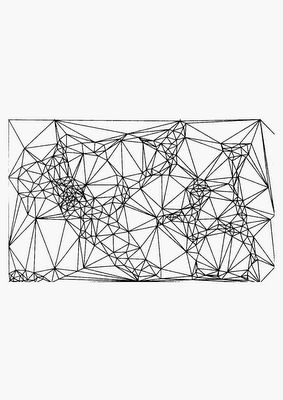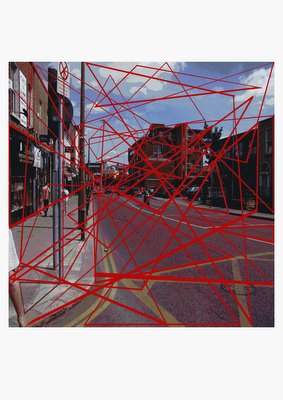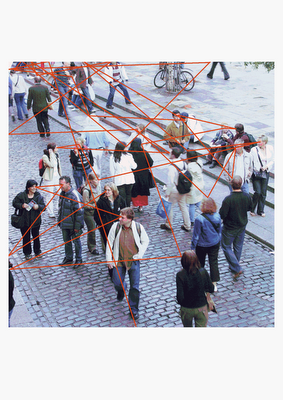Joe Hanly (DIT) Tiangle Project



A Triangulational Aesthetic
This project has, surprisingly enough, afforded me a welcome opportunity to talk about triangles, something, until now, I would never have been caught dead doing, in spite of the fact that I’ve always had a special place in my art fort a triangle or two. For me the triangle has helped as a kind of thinking device for working my way through or around problems. As I saw it, a problem often consisted of two competing components finding themselves together in a contested space getting no further than a frustrated and often static impasse alleviated only when an appropriate third component is identified and introduced into the mix. It would become a “ménage a trois” in which each component would act as a catalyst for the other two to reveal themselves in a full and active dynamic. This triangular relationship has served as a device for realising work and for identifying the nature of its discourse. It has informed my teaching practice and proved a valuable aid to the setting of course projects. It has also functioned as a type of mental drawing for use not only to negotiate my own work but also to negotiate real life situations out in the big world. In fact, if really pushed, the “ménage a trois’ can be projected onto any situation one cares to think about. Now I keep finding triangles in spaces I didn’t even know had angles.
When starting out on this Triangle Project for want of something better to do I decided to take the word itself and play about with it in order to see what it might throw out. Among the words I came up with were triangulationship, striangulation, entrianglement etc but the word, which returned something more engaging, when googled, was “Triangulation”. Although used in statistical analyses and in navigation, more interestingly for me this word revealed “Delauny’s Triangulation” a system, invented in 1943 by a Russian mathematician Boris Delauney, for taking complex geometric objects and breaking them down into their simplest possible geometric object which is the triangle. This is now apparently one of the main techniques used to create 3D computer graphics. Although not appearing, as yet directly, applicable to anything here the resulting drawings of this process seems to offer a flexible structure ideal for a visual approximation of what I consider to be mental drawing.
While trying to ponder life’s enigmas over the years there were a number of writers that interested me, whose work required some serious mental drawing in order to get a handle on it. Amongst these there were a few obvious suspects such as Derrida, Barthes and Chomsky. Triangles of varying complexities were required in order to come to terms with such works as Roland Barthes’s “Mythologies” with its references to the Signified, Signifier and Sign as it multiplied into multilayered triangular readings of cultural situations and historic events and Jaques Derrida’s endless deferral of meaning back through other meanings and traces of meanings in “Margins of Philosophy” and his deconstruction of western cannons of truth established throughout a logo-centric tradition of binary oppositions. Also in the not so triangular Naom Chomsky’s “Universal Grammar”, in which he suggests that there is a universally innate and complex grammatical scaffolding that grows in the mind/brains of children, autonomous of environmental conditions but in tune with their biological development, in order to handle the vocabulary that they are acquiring no matter where in the world they come from. Finally, late to this group, comes Edward Soja, social geographer and a true man of the triangle, of whom I have become come aware more recently, who in his book “Thirdspace” has enlisted Henri Lefebvre, of, one time, situationist fame, in taking Hegel’s dialectic and reconstituting it into a spatial trialectic. To this intensive bout of mental drawing comes Delauney’s Triangulation, which provide an intricate visual system that, for me, seems to fit it all like a glove. (image 1)
”Delauny’s Triangulation” interactive site, worth checking out:
< http://www.cs.cornell.edu/Info/People/chew/Delaunay.html >
One of those triangles, that I keep finding everywhere, I have found in a space, more commonly frequented by psychologists, political and historical analysts and perhaps even social geographers but it is a space that is not totally unknown to the odd self-opinionated artist either. The triangle is situated within a three-way relationship of traits basic to the nature of an individual’s personality. It is a “Holy Trinity” of the psyche that consists of (a) A rational component (b) An intuitive component and (c) An Instinctive component. In this triangular relationship, a, b and c make up the triangle and the personality is positioned within it, like a pointer in a triangular colour palette of some graphics software, benefiting proportionately from each of (a) the rational, (b) the intuitive and (c) the instinctive. This is certainly not the most complete or accurate picture of what happens but its not too far off either and it is sufficient for my purposes here. I find that that basic triangular arrangement of traits has a very interesting outcome when it is taken from the micro situation of the individual psyche and is projected onto the macro situation of the collective psyche. There you can have such threesomes as Politics, Commerce and Culture or things Material, Imaginary and Spiritual. You can also have such wonderful mixes as Totalitarianism, Democracy and Anarchy or Classical, Traditional and Contemporary; Realism, Idealism, Fantasy etc. My point here is that since these positions really actually only reflect human constructs or interpretations of society’s complex relationships, each of the components in a group is likely to bear a loose resemblance to a general personality type which would have been fundamental to its conception. In other words each position within a group would gravitate towards a particular type of personality and visa versa although always retaining something of the other types in the group too. Things begin to hot up when one component in a group becomes dominant over the others or more commonly when two components become so actively engaged in a struggle between each other that they are distracted from or forget about the possibility of a third component leaving it out in the cold to continue developing unobserved all on its own. This tends to happen in the logo centric world, described by Derrida, where every position is perceived as being in some natural binary opposition to another, like good and bad or black and white, where there are only grey areas that exist in between. However, in a trialectic world, although not quite that of Soja’s rather netherworldly “thirdspace”, every position might be in a tri-polar relationship like that of red, yellow and blue in the colour wheel (sorry triangle) with the space between being any one of a multiple of contrasting or complementary colours and shades.
One task might now be to find two apparently polar oppositions, which are locked in combat with each other, completely oblivious to the existence of a third component bubbling away in the background. (A classic example could be Left wing versus Right wing). Then assign to those components their appropriate personality traits within the triangle. When that is done try to identify a third component that will fit an alternative personality trait within that same mix. (So! In the case of the classic example above, what could the third component be? All suggestions welcome or any other banter at all. Be adventurous!).
Where does that now leave us? Nowhere really except that we end up with lots of lovely triangles strewn all over the place and the next time that an old reliable pendulum stops swinging in a predictable motion back and forth between two polar oppositions but swings erratically and unpredictably all over the place it is time to throw a spanner into the works. I think I feel a few squares coming on now.
With more modest intent, the triangular relationships in my work, produced for this project, “Entrianglement” (image 2.) are established between diverse elements, in the photograph of Rathgar/Rathmines junction, such as between an elbow, road markings and a cloud and in ”Triangleyes” (image 3) the relationship is between the eyes of those walking through Temple Bar Square. In this piece the relationship is not triangular but it produces lots of incidental triangles which open up further possibilities.

0 Comments:
Post a Comment
Subscribe to Post Comments [Atom]
<< Home